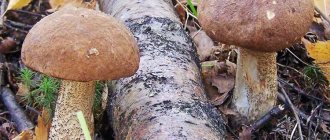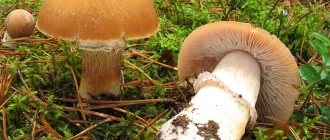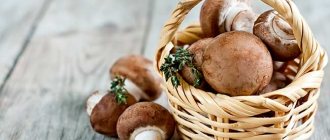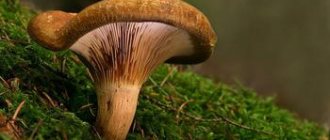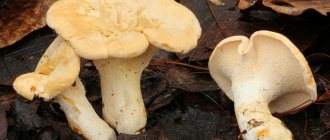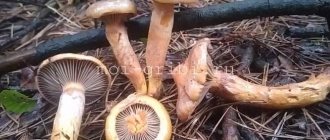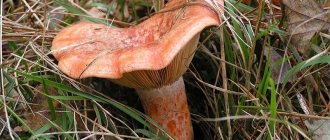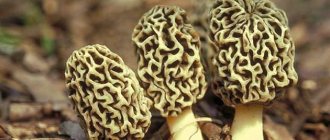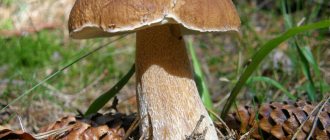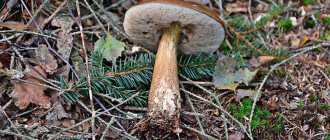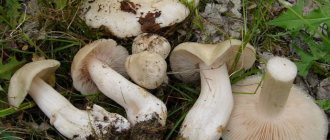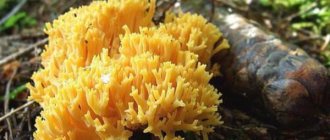Morphological features
In order not to confuse boletus, boletus or porcini mushrooms with different types of boletus, you should remember that it has a thinner stem and less dense cap flesh. Boletus mushrooms are early, first and precocious noble mushrooms that appear in our forests.
The name boletus stems from the fact that the fruiting bodies most often grow under birch trees, forming mycorrhizae with the root system of this deciduous tree. Some type of edible russula very often grows near birch trees, for example, birch russula or R. Betularum, which is popular among mushroom pickers. Berezovik, often growing in small groups, bears fruit quite regularly, but in waves.
Where and when do boletus grow?
The name of the fungus is associated with the formation of microrhiza with birch, and occasionally with aspen or pine. Therefore, wherever there are birch groves or individual trees mixed with other species, this type of mushroom can grow.
To find boletus in the forest, you must remember that this mushroom does not like direct sunlight. It hides in bushes, tall grass or under a layer of fallen leaves.Therefore, to find young individuals, you need to look closely. Or rake up grass and dry leaves with a stick.
Boletuses appear around July and continue to grow into the autumn months. Rainy summers may cause mushrooms to appear earlier.
According to observation, each individual gains 4 cm in height per day. 6 days after emergence it becomes too old to eat. Therefore, mushroom pickers try to go into the forest the next morning after rain in search of young boletus mushrooms.
Growth and fruiting period
The mycorrhizal fungus L. melaneum grows on damp soils of pine and birch forests, as well as in high marshy areas from July to September. Swamp birch grass forms mycorrhiza with birches and is most often found in damp, swampy, mossy areas in mixed forest zones. The tough boletus prefers calcareous soils, as well as sandy and loamy soils of deciduous and mixed forests, where it bears fruit quite abundantly from the last ten days of July to the first days of November.
Hornbeams bear fruit from the beginning of summer until the onset of noticeable cold weather. This is the species that most often forms mycorrhiza with hornbeam, but can also grow under deciduous trees such as birch and poplar. Blackening obabok is characterized by the formation of mycorrhizae with oaks and beech, and appears singly or in small groups from June to the last ten days of September.
What does boletus look like?
Poisoning from poisonous mushrooms can be fatal due to the highly toxic substances they produce. Therefore, a novice mushroom picker should remember the main characteristics of the mushroom they need: the cap can reach 15 cm in diameter and its color can range from gray to black, including spotted and gray-brown.
The legs of the boletus necessarily have thickenings and scales. The tubular layer of the mushroom depends on age: from white in young growth to dirty brown in mature ones. The flesh of the mushroom is white or pale pink without a pronounced taste or smell.Anyone who goes into the forest for the first time needs to take a photo of boletus mushrooms so that, in case of doubt, they can visually compare the found individual with the sample.
Depending on the area, the boletus may have a slightly different appearance. For example, in humid deciduous forests, boletus mushrooms are considered to be mushrooms with a thin stalk of olive or brown color.
In dry forests they have thick, scaly legs. In these cases, edibility is determined by the dense and aromatic pulp. Separately, the marsh boletus is distinguished with greenish caps, on thin legs with watery pulp.
Photo gallery
False boletus
Death cap
Mushroom hunters without experience collect poisonous toadstool under aspen, birch, and beech trees (as well as boletus), and confuse it with the marsh subspecies. But this poisonous mushroom has no antidote.
The cap of a young grebe is up to 10 cm in diameter, spherical, flattens and shines with age. The surface is light, sometimes greenish or olive. Under the cap there is a specific cuff. The slender stem without scales is widened at the bottom and located in a kind of capsule.
The pulp exudes a pleasant mushroom aroma, fragile, white, sweet. It is distinguished by a hymenophore on the lower part of the cap. The whitish wide plates are clearly visible from below. In this way, the toadstool is not similar to the tubular boletus mushroom.
Bile mushroom
People do not eat it; the gall fungus is bitter and pungent in taste. Conditionally poisonous, it looks like a pink boletus.
hat
The shape is a shiny hemisphere, does not exceed 15 cm in diameter. The surface is brownish or light chestnut.
Stem
There is a dark mesh pattern on the stem near the cap; it is thickened in the middle.
When broken, the bitter, whitish body turns pink, which is what the false mushroom imitates the pink boletus. Regardless of the exposure, the tubes of the false mushroom do not lose their bright pink hue. The difference is that in the edible species the layer of tubes is creamy and turns pink at the break.
Types of edible boletus: description and characteristics
All types of boletus are edible and differ slightly in appearance and nutritional quality. Experienced mushroom pickers know which species have the greatest nutritional value and have the most delicious fruiting bodies.
| Latin name | Birch species | hat | Pulp | Leg |
| L.melaneum | Black | Dark brown or black in color with rather large tubes | Without pronounced taste and aroma, relatively dense | Straight, with small black scales on the surface |
| L. holopus | Bolotny | Convex or cushion-shaped, light in color, with a dry surface | White with a greenish tint, soft, slightly watery | Thin, elongated, with a grayish surface |
| L. duriusculum | Harsh | Hemispherical or cushion-shaped, matte, in brown tones | Dense, with a yellowish-green tint, with a pleasant taste and mushroom aroma | Cylindrical or fusiform, covered with brown scales |
| L. carpini | Gray or hornbeam | Hemispherical or cushion-shaped, dry, matte, brown-brown-gray shades | Colored pink-violet when cut, dense, relatively aromatic | Club-shaped or cylindrical, covered with light scales |
| L. scabrum | Ordinary | Almost all shades of gray and red-brown, smooth, convex shape | White or pinkish in color at the break, with a pleasant taste and aroma | With thickening in the lower part, white, with longitudinal scales |
| L. variicolor | Multicolored | With a mottled surface, characteristic dirty brown coloring | White in color, colored soft pink when cut, pleasant taste, with a slight mushroom aroma | Has a bluish tint to the surface in the lower part |
| L. leucophaeum | Ash gray | Hemispherical or cushion-shaped, dry, matte, light brown in color | White, colored pale pink when cut, with a mediocre taste and a slight mushroom aroma | Thin and long, white, covered with dark and loose scales |
| L.crocipodium | Blackening or checkerboard | Hemispherical or cushion-shaped, with blunt edges, yellowish-brown in color | Light yellow color, soft consistency, wine-red or violet-brown color on the cut | Cylindrical or club-shaped, thickened in the lower part, covered with yellowish scales |
| L. oxydabile | Pinkish | Convex or cushion-shaped, grayish-brown in color with a marbled pattern on the surface | White color, fairly high density, acquires a pink tint when cut | Long, relatively thin, thickened at the bottom |
A similar species, commonly called “false boletus,” is Tylopilus felleus or gall mushroom. The raw pulp of the bitterling fruit body has a fairly pleasant sweetish taste, but during heat treatment a very strong bitterness appears, making this species unsuitable for consumption for food purposes.
What mushrooms grow on and under birch trees?
Polypores live on tree trunks and their very useful variety is chaga. The most popular edible mushrooms are oyster mushrooms, honey mushrooms, milk mushrooms, boletus mushrooms, boletus mushrooms, boletus mushrooms and russula mushrooms.
Edible
Most birch forest mushrooms are not only tasty, but also healthy. They contain many microelements, vitamins, salts, and carbohydrates that are important for human health.
Oyster mushroom
Today this mushroom can be bought in almost all stores. Oyster mushroom is readily cultivated by amateurs and farmers; it provides a good income.
However, gourmets claim that mushrooms grown in natural conditions are much tastier, more aromatic and healthier than homemade ones.
Oyster mushrooms grow on old and young birch trees, on fallen trees and even dead wood and decrepit stumps. It is completely unpretentious and very productive.
The most common types of oyster mushrooms growing in birch groves:
- Elm (lemon);
- Abundant (horn-shaped);
- Stepnaya;
- Pink;
- Pulmonary;
- Royal (the only variety that grows on the ground rather than on a tree).
Different types of oyster mushrooms ripen from early spring to late autumn. The main thing is suitable weather conditions, since the mycelium germinates at temperatures from 5 to +20 ºС. Therefore, most types of oyster mushrooms can be collected in August-October. But the royal one grows exclusively in the spring.
Reference! The main value of oyster mushrooms is considered to be their ability to fight cancer. Regular consumption of these mushrooms blocks cell mutation, preventing the formation and development of cancerous tumors.
Edible honey mushrooms
Representatives of this family of mushrooms can be collected almost all year round - there are spring, summer, autumn and winter types of honey mushrooms. They prefer to settle on dead or dying birch trees.
These mushrooms in the birch forest usually grow in large groups and have a huge supply of useful elements, vitamins, fiber and amino acids. The calorie content is very low, so they can be included in weight loss diets.
Birch honey mushrooms have antitumor properties and help treat many types of severe infections, such as staphylococcus, tuberculosis, and E. coli.
Even official medicine uses drugs made from these mushrooms.
You can go for honey mushrooms in any weather, but it is best during or immediately after rain. Like any other mushrooms, this type of fruiting body tends to absorb harmful substances from the air, so they should not be collected near populated areas, industrial enterprises or highways.
Reference! Honey mushrooms are the “culprits” of a curious phenomenon - the night glow of stumps in the fall. Previously, it was believed that this was a glowing gas emitted by the fruiting bodies themselves. In fact, this effect is caused by mycelium, which entangles the wood in a thin network.
boletus
One of the most delicious mushrooms, in terms of its nutritional qualities it ranks second after white mushrooms. There are several varieties of boletus, but all of them are edible. This mushroom has no poisonous counterparts at all.
Boletus prefers to grow in more or less open and well-warmed by the sun places - forest edges, clearings, near forest roads. There are also a lot of them in young birch forest plantations.
But there are also those that grow in partial shade, lowlands, along the edges of swamps and streams. Most species of boletus bear fruit from June to October, some specimens are also found in November.
Important! This mushroom got its name not only because it grows under a birch tree, but also because its stem resembles the trunk of a tree in color.
White milk mushroom
The most favorite “hunt” for mushroom pickers is the king of pickling. Since ancient times in our country, milk mushrooms have enjoyed popular love and are used in folk and official medicine.
The milk mushroom loves old birch trees; it cannot be found in young plantings. Prefers fairly moist places in which dense undergrowth grows. Finding milk mushrooms is not easy.
Most often, experienced mushroom pickers look for them by smell: in places where they grow there is a specific aroma. It loves milk mushrooms and hides in the forest floor, under leaves and even underground.
The ripening period is short - from mid-August to October, when the most comfortable temperature for it is established - 8-10 ºС. After the rains, the chances of collecting a full basket of milk mushrooms increase noticeably.
By the way! Such mushrooms are soaked before salting because of their caustic milky juice. If this is not done, the milk mushrooms will simply be impossible to eat.
Porcini
The king of the forest is the boletus. It’s not for nothing that they call it “forest meat.” The amount and value of protein in boletus is comparable to beef meat. A large set of vitamins, amino acids, polysaccharides, microelements benefit the body and help in the treatment of many diseases.
The mushroom was named porcini because it does not lose its original color with any type of culinary processing. Boletus grows only in old birch forests over 50 years old. It likes fairly dry forest floor and sunlight.
Therefore, searching for porcini mushrooms in a young birch grove with dense undergrowth is useless. Under favorable weather conditions, boletus mushrooms can be collected from July-August to mid-September.
Reference! In dishes prepared from dried porcini mushrooms, the digestibility of complete protein increases to 80%, while in fresh ones it is quite low due to the presence of chitin.
Russula greenish
Fully lives up to its name, without changing color throughout its life. It belongs to the conditionally edible mushrooms of a low food category. After cooking it has a rich taste and a light nutty aroma. This variety of russula is found infrequently; it grows mainly singly. Prefers open clearings near birch trees and leaf litter.
The beneficial properties of greenish russula are not inferior to mushrooms of the first category. Vitamins, microelements, protein, amino acids contained in the fruiting body almost completely retain their properties after cooking.
The ripening period is from July to September, depending on weather conditions. In dry summers or during prolonged heavy rains it practically does not occur.
Reference! This mushroom began to be called “russula” because previously it was considered quite safe to eat it without cooking.
Volnushka white
Another “lover” of the birch forest belt. Prefers marshy soils. Under favorable weather conditions (warm summers with frequent short rains) it is capable of producing gigantic harvests. Most often it grows among moss in whole families of 10 to 14 pieces. You can collect white moth from July until the end of October.
Important! This mushroom can be frozen for long-term storage without cooking. This way it will preserve all its beneficial properties throughout the year.
Other
In birch plantings there are also edible mushrooms such as puffballs, saffron milk caps, champignons, boletus, chanterelles, valui, morels, strings, aspen mushrooms and even truffles.
Inedible
Mushrooms growing in birch plantings are not only tasty and healthy. To prevent your mushroom hunting trip from ending in failure, you should know that inedible fruiting bodies can also be found in the forest.
Thin pig
Not so long ago, this mushroom was classified as conditionally edible, but since 1981 it has been listed in reference books as poisonous. Our ancestors collected pork, boiled it, salted it, and pickled it for future use.
It received this name because the hat resembles a pig's snout. Peak ripening occurs between July and September.
This mushroom has a certain resemblance to the black milk mushroom. Therefore, inexperienced “hunters” should know the signs by which they can distinguish a poisonous fellow:
- In black milk mushrooms, the flesh becomes gray when cut, while in pork mushrooms it turns brown or black.
- An edible mushroom has a depressed cap in the center, while a poisonous one has a hollow funnel-shaped cap.
Symptoms of poisoning with toadstool are similar to poisoning with toadstool. Only they are not so pronounced and death is less likely.
Russula brittle
This type of inedible mushroom is familiar to many. Russula brittle is very common, and not only in birch forests. It has a characteristic appearance: a pale purple cap with a carved edge from translucent plates, a white stem with a powdery surface.
You can get poisoned by Russula brittle only if you eat it in very large quantities. When prepared appropriately, it is safe, but not particularly tasty - the bitter aftertaste remains even after prolonged cooking. In official and folk medicine, this mushroom is used to strengthen the immune system and the vascular system.
Dangerous
You need to be very careful when collecting forest gifts, since there are species that pretend to be useful, but in fact are extremely dangerous.
Every year, dozens of people become victims of satanic mushrooms, fly agarics, and toadstools. Some people, out of inexperience, and others, for medicinal purposes, eat something that you shouldn’t even touch with your hands.
Satanic mushroom
Successfully disguises itself as a boletus. You should know the distinctive signs of a satanic mushroom so as not to carry it away in a basket.
You can meet it from June to September not only in birch groves, but also in other deciduous forests.
Characteristics of the Satanic mushroom:
- Its leg in cross section has a blue color, which after a short time changes to bright red.
- The smell from a ripe mushroom is reminiscent of onion or cabbage rot.
- The flesh of the cap is pale, and when cut, it gradually acquires a bluish tint.
The danger of the satanic mushroom lies in the alkaloids it contains, typical of fly agaric mushrooms. Mycologists classify this species as conditionally edible. This means that they can be eaten after prolonged soaking and cooking for at least 10 hours.
Some scientists classify the satanic mushroom as poisonous, since it is impossible to determine the amount of poison contained at home. There is a high risk of severe poisoning.
Death cap
At the end of August - beginning of September, this most poisonous mushroom in the European part of Russia ripens. It grows everywhere, not only in birch, but also in mixed and coniferous forests. It belongs to the fly agaric genus and is extremely toxic. Just 100 g (a third of the fruiting body) can kill an adult.
You can distinguish them from mushrooms similar in appearance by their characteristic features:
- The leg is covered with flaky white scales.
- On the upper part of the leg there is a membranous ring, and on the thickened lower part there is the same ring in the form of a pale green bag.
- The cap is white, with a hint of butter color in the center and in most cases with the remains of a white cap around the edges.
Symptoms of poisoning with toadstool do not appear immediately, but when the poison has already penetrated all internal organs. Therefore, first aid to the victim does not make sense.
The main symptoms of poisoning with toadstool:
- repeated vomiting;
- severe diarrhea;
- unquenchable thirst;
- severe abdominal pain;
- dehydration.
If you place a patient in a hospital in time, you can alleviate his condition and prevent death. Unfortunately, there is currently no treatment.
If the body is weakened, especially the cardiovascular system, death is inevitable. But in most cases, patients manage to recover, although rehabilitation can last several months.
fly agaric
The most famous (even for children) poisonous mushroom of the birch forest. Unlike its previous relatives, symptoms of fly agaric poisoning appear within 15 minutes after consumption. Its cap is red, bright yellow or orange with white specks of flakes over the entire surface (remnants of the bedspread).
Gradually, as the mushroom ages, the flakes are washed away by rain and there is a danger of confusing it with its harmless counterparts. The leg is white, with a tuberous thickening at the bottom and a characteristic skirt at the top or middle of the leg.
The mushroom cap contains life-threatening hallucinogens, alkaloids and other toxic substances. There are many types of fly agarics, and all of them are poisonous. The dose contained in about 15 mushrooms is lethal.
Specific symptoms of fly agaric poisoning:
- hallucinations, delirium, clouding of consciousness;
- diarrhea mixed with scarlet blood;
- vomit;
- headache;
- convulsions.
Unlike the toadstool, there is an antidote for the poison of the fly agaric - atropine. During inpatient treatment, specific therapy is also carried out, including glucocorticoid drugs and maintaining the functions of internal organs. Seeing a doctor is necessary, otherwise death is possible.
Chemical composition
The benefits and taste properties of boletus are determined by the chemical composition of its pulp. With a caloric content of 20 kcal, boletus mushroom pulp contains:
- proteins – 2.3 g;
- fat – 0.9 g;
- carbohydrates – 1.2 g;
- dietary fiber – 5.1 g;
- water – 90.1 g;
- ash – 0.7 g.
The fruiting bodies of birch trees contain a significant amount of mineral elements and vitamins:
- thiamine – 0.07 mg;
- riboflavin – 0.22 mg;
- ascorbic acid – 6.0 mg;
- alpha tocopherol – 0.1 mg;
- vitamin PP – 6.7 mg;
- potassium – 443.0 mg;
- calcium – 6.0 mg;
- magnesium – 15.0 mg;
- sodium – 3.0 mg;
- phosphorus – 171.0 m;
- iron – 0.3 mg;
- manganese – 0.74 mg.
What does the boletus mushroom get from the birch tree?
The boletus supplies the birch with minerals, and the birch supplies the fungus with nutrients. This is called symbiosis.
Interesting materials:
RVP what's next? What does fish oil contain? Fish oil benefits and harms how to take? At what age is TIN issued to children? From what area is UTII paid? Which side is the lamp on the desk? What page does the magazine number start on? What currency should I use to travel to Dubai? S7 how many KG luggage? S7 How long does it take to register?
Benefits and harms
The pulp of birch trees is not only quite tasty, but also healthy:
- the presence of dietary fiber allows the mushroom pulp to absorb and remove absorbed toxic substances and harmful elements from the body;
- The excellent antioxidant effectiveness of boletus has been proven, which allows its use in the prevention of cancer;
- mushroom pulp has a beneficial effect on the nervous system, as well as the condition of the mucous membranes and skin;
- the presence of a significant amount of phosphoric acid helps to improve the functioning of the musculoskeletal system and prevent osteoporosis.
The special value of boletus lies in the presence of a well-balanced protein composition: tyrosine, leucine, glutamine and arginine are digested as quickly as possible and are easily absorbed by intestinal cells. Also, boletus fruiting bodies are able to normalize blood sugar levels, which is why they are considered especially useful for diabetes.
Medicinal birch mushroom Chaga
The asexual form of the tinder fungus is called Chaga. The mushroom is also called black birch mushroom, as it grows on the trunks of birch trees. The fruit does not have clearly defined parts and is gray in color with a brown tint. This species is considered a parasite, since it enters the cracks of the trunk in the form of a spore and subsequently parasitizes it.
The inside of the fruit is brown with a reddish tint. The weight of one fruit part can reach 3 kg. It is collected at any time of the year only from healthy living trees. After this, the fruit is dried, cut into pieces and placed in jars.
The mushroom is not used in cooking, but is widely used in folk medicine. Thus, it is used to treat cancer, reduce blood cholesterol levels, normalize the gastrointestinal tract, restore the functioning of the central nervous system, improve immunity and treat inflammatory processes of the skin.
Such a wide spectrum of action is associated with the presence of a large number of useful substances, minerals and vitamins in the composition. To use Chaga, decoctions and tinctures are prepared from it by boiling the fruit.
Important!
Despite the usefulness of Chaga, it is not recommended for use by children under 12 years of age, pregnant women, people taking penicillin-based antibiotics, and patients with dysentery.
You may be interested in:
How to recognize a mushroom with a cap and a white stalk: names and types (32 photos) Mushrooms are a wonderful culinary product, successfully used for preparing various dishes. The most…Read more…
Cooking features
It is recommended to cook and consume boletus and aspen mushrooms together with other types of edible mushrooms, due to the not very pronounced taste of their pulp. All types of boletus belong to the category of edible mushrooms , but in order to prepare a high-quality mushroom dish, preliminary treatment of the fruiting bodies in the form of cleaning from forest debris and washing under running water is required.
Boletus mushrooms have one more feature that needs to be taken into account - the mushroom pulp darkens very quickly, regardless of the method of heat treatment. Therefore, to maintain an attractive appearance, before boiling boletus mushrooms, their peeled fruiting bodies must be soaked in water slightly acidified with citric acid.
Recommendations for preparing mushroom dishes from birch trees:
- fry the fruiting bodies of boletus mushrooms, cut into pieces, preferably after boiling, during which the mushrooms need to be salted;
- a good side dish for fried mushrooms are potato and cereal dishes, as well as vegetable stew with onions and carrots;
- boiled or fried boletus mushrooms are perfect as a savory mushroom filling for making homemade pies and other types of baked goods;
- you can bake boletus mushrooms with potatoes and cheese in clay pots and serve with sour cream and fresh dill;
- Only the strong caps of the youngest specimens with dense flesh can be salted and pickled;
- Freezing boletus mushrooms, previously cleared of soil particles and forest litter, allows you to enjoy their taste and aroma in the winter.
Collection and consumption of birch mushrooms
The time when you can enjoy a bountiful mushroom harvest depends entirely on the climatic conditions of a particular region and the type of fruiting body. But in rainy weather, birch mushrooms are much more common. Therefore, lovers of quiet hunting prefer to go into the forest during or immediately after precipitation.
Mushroom pulp is capable of absorbing all harmful substances contained in the atmosphere. Therefore, experts strongly recommend harvesting in places that are located far from industrial enterprises and landfills, areas of roads and railways. At the same time, areas after forest fires are some of the best for silent hunting.
Today, honey mushrooms can not only be found and picked in a birch grove, many people buy them in stores. There are a number of reasons for this:
- Products grown under artificial conditions are safe for consumption.
- Mushrooms are no different from their forest counterparts, including their taste and beneficial properties.
- Raw materials can be thoroughly checked at all stages, from planting to packaging of fruiting bodies.
You can use birch honey mushrooms in different variations:
- Making soups.
- Frying.
- Pickling.
- Salting.
- Boiling.
- Drying.
- Baking.
- Use as a filling for dumplings, kulebyak and pies, as a base for salads and vegetable caviar.
Attention! In some countries of the world, birch mushrooms are considered poisonous. In fact, they are classified as conditionally edible.
Experts recommend not consuming fresh mushrooms. It is best to pre-boil the raw material and only then use it to prepare a variety of dishes.
